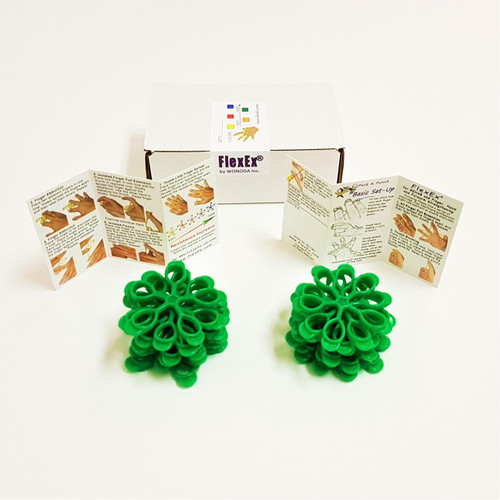FlexEx® - Health Hand Exerciser
1 Yellow (soft), 1 Orange (medium-soft), & 1 Red (medium)
This pack is perfect for those with weakened hands due to repetitive injury such as carpal tunnel, tennis elbow, etc. or those looking to rehabilitate hands and fingers post-surgery. Pack includes 3 resistances so you can strengthen your hands gradually by starting with the yellow FlexEx and working your way up to the Red One!
The Yellow FlexEx offers light resistance and is used for physical therapy, rehabilitation, and by those with weakened hands possibly due to carpal tunnel syndrome or post-surgery, etc.
The Orange FlexEx offers Medium/Light resistance and is perfect to use after you have strengthened your hands with the yellow ones and need a bit of a challenge to continue your strengthening program.
The Red FlexEx offers medium resistance and is suited for most individuals wishing to strengthen their hands, forearms and fingers e.g. computer users, and those who play a musical instrument.
Strengthen your hands the simple, easy way with FlexEx, for Strong, Healthy, Pain-Free Living!
Strengthen your Hands and Improve your Sport with the FlexEX HEALTH!
Proudly Manufactured and Packaged in the USA!
Carpal Tunnel
Carpal tunnel syndrome is pressure on the median nerve – the nerve in the wrist that supplies feeling and movement to parts of the hand. It can lead to numbness, tingling, weakness, or muscle damage in the hand and fingers.
The median nerve provides feeling and movement to the “thumb side” of the hand (the palm, thumb, index finger, middle finger, and thumb side of the ring finger). The area in your wrist where the nerve enters the hand is called the carpal tunnel. This tunnel is normally narrow, so any swelling can pinch the nerve and cause pain, numbness, tingling or weakness. This is called carpal tunnel syndrome.
DeQuervain’s Tenosynovitis
Definition – Tenosynovitis implies inflammation of a tendon and its enveloping sheath; deQuervain’s tenosynovitis is a specific type of this entity which involves the tendons of two specific muscles on the thumb side of the hand – the abductor pollicis longus (APL) and the extensor pollicis brevis (EPB). These muscles are located in the forearm and their tendons travel across the wrist (through a “tunnel” termed the first dorsal compartment) on the thumb side to produce movement of the thumb. The walls of the affected tendon sheaths (basically protective coverings for the tendons) become thickened and inflamed, causing the symptoms described in the next section. The condition is 10 times more common in women, more often arises in the dominant hand, and usually occurs between the ages of 35 and 55.
Signs and Symptoms – Patients typically complain of the gradual onset of pain over the area indicated above by the red dot (over the radial styloid, an area of a bone in the forearm) when they use their thumb on the affected hand. The sufferer may relate that the pain has gradually increased over that past few weeks or months. The patient experiences difficulties with gripping and pinching, and in severe cases, the affected hand may be too painful to use. The pain may radiate into the thumb, or up into the forearm or shoulder. Examination of the affected area reveals thickening and tenderness. A test commonly used to evaluate the presence of this disease is Finkelstein’s test. The patient is instructed to grasp the thumb of the affected hand with the other fingers and actively pull the thumb towards the small finger. Sharp pain will be elicited over the area indicated by the red dot if the patient suffers from deQuervain’s tenosynovitis. This condition must be differentiated from arthritis at the base of the thumb. If the disease is allowed to progress without treatment, it is possible that fibrosis within the tendon sheath may result and a clinical picture similar to trigger finger may result with limited motion. Ultrasound examination has recently been used to confirm the diagnosis and can be used to follow up after treatment.
Possible causes – The precise cause of deQuervain’s tenosynovitis is unknown. It is thought that excessive friction from overuse of the thumb and wrist (excessive and repetitive gripping and grasping actions) may be a factor, leading to thickening of the tissues in the compartment housing the APL and EPB tendons. For example, cases have been described in bricklayers, those who sew, piano players, fly fishermen, and golfers. It has also been hypothesized that the condition in some cases may be associated with acute injury to the involved area (direct blow to the forearm or wrist, falling on the thumb). However, most cases appear to be associated with a more monotonous, “chronic trauma” picture as mentioned above.









